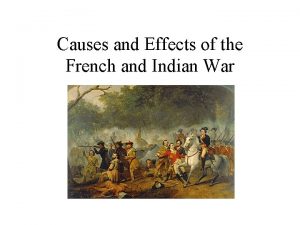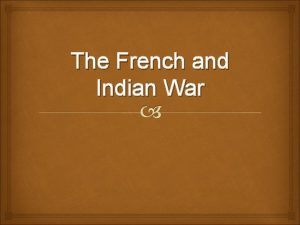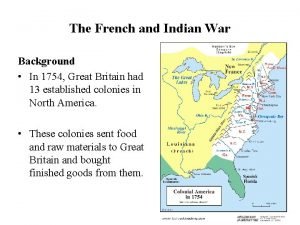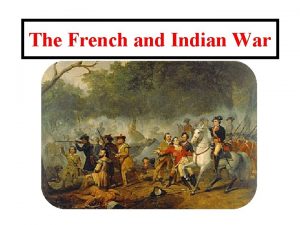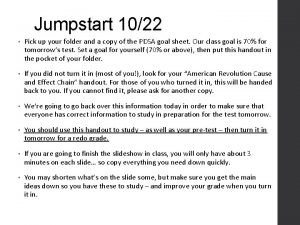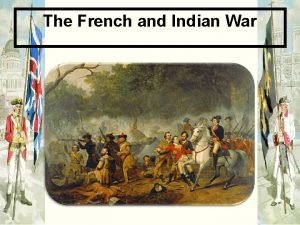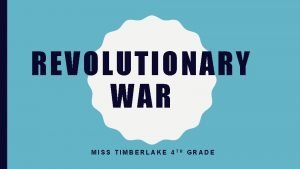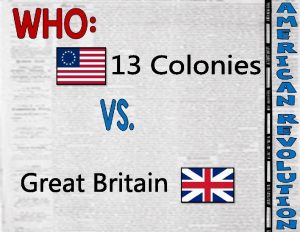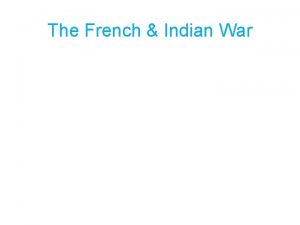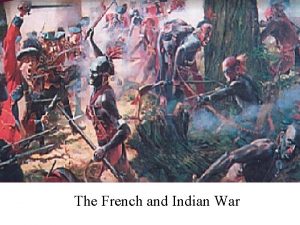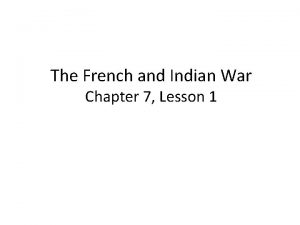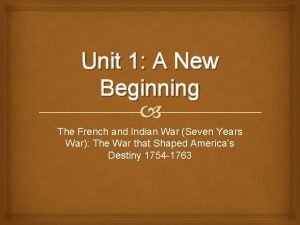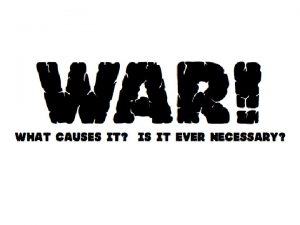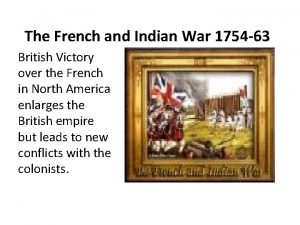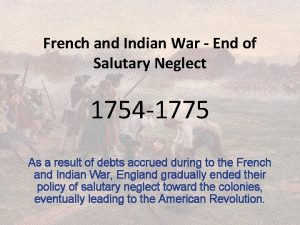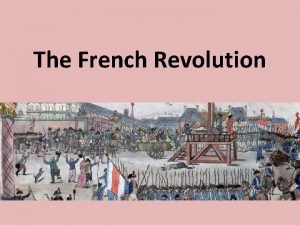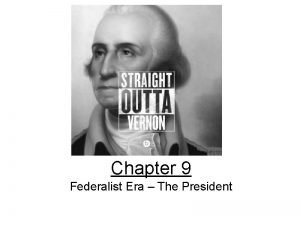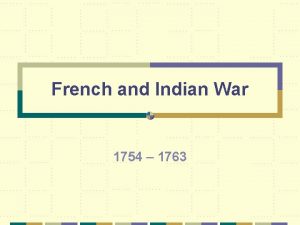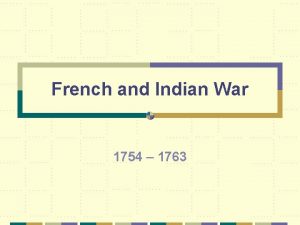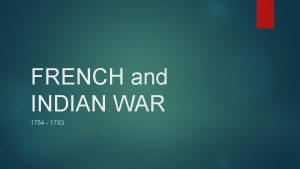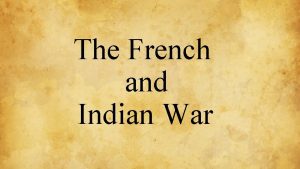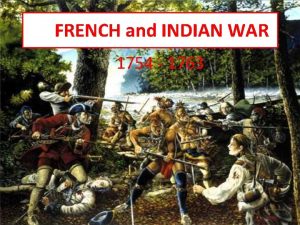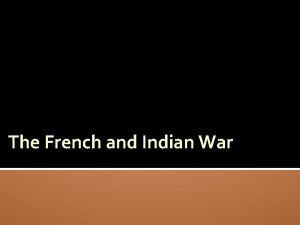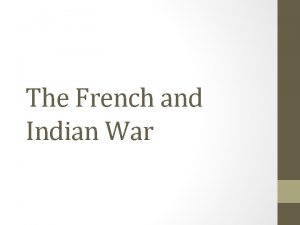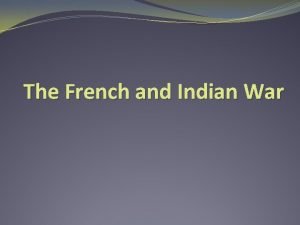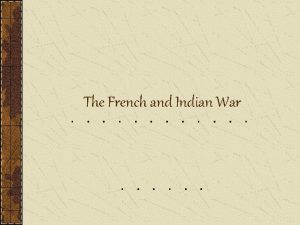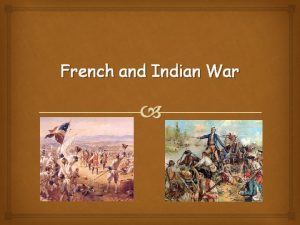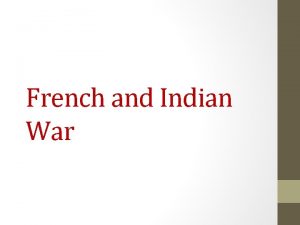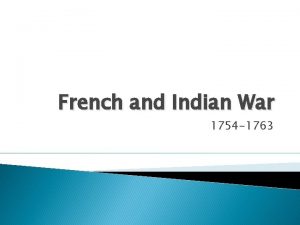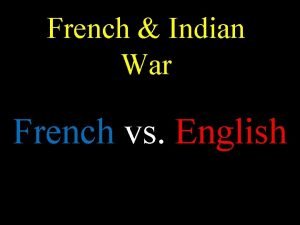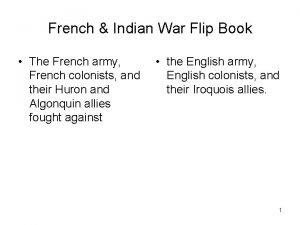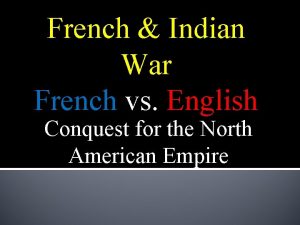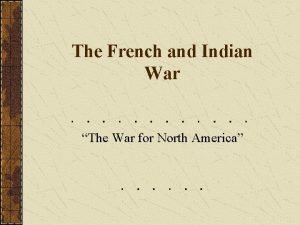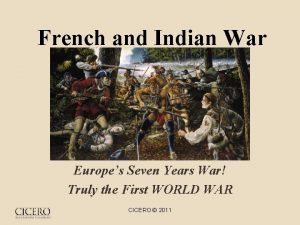French and Indian War French and Indian War





























- Slides: 29

French and Indian War

French and Indian War �Colonial competition in North America between continental rivals Great Brittan and France would eventually lead to a war that would envelope the colonies.

Reasons for the French and Indian War Earliest & most important industry for French (business) in North America 1500 s-1800 s Beaver fur was used to make hats, they were the fashion in European tensions lingering from the War of Austrian Succession caused continental pressures as alliances shifted. English colonists bought 500, 000 acres of land in the Ohio Valley to farm. This would hurt the French colonial fur trade.

French in North America • Land was originally claimed by French explorers. • French fur traders used the Ohio River area for fur trading. French gov’t built forts to stop English taking the land.

British in North America • The English colonies grew and prospered. New colonists were looking for more land. • Free or cheap land offered new opportunities and economic freedom. English government built forts and started to grant land to its citizens.

French and Indian War A. French have better relationships with Indians. B. English wanted to take their land for farming. � Most French colonists were fur traders and trappers. C. French only wanted the fur. They didn’t want to stay on the land. � � They lived among the Indians and adopted their ways. They learned to make canoes, trap animals, make snow shoes, and etc. . They learned Native American languages. They took Indian brides. Bi-racial children

George Washington �Washington began his military service in the French and Indian War as a major in the militia of the British Province of Virginia. �He was intending to join the Royal Navy at the age of 15 but due to the wishes of his mother gave up such ambitions

George Washington � With a background as a surveyor in Virginia and from an established family…Washington was commissioned as a Major in the colonial militia. � At 21 years old he lead a mission into the Ohio Country to assess the French military situation, and to deliver the British demands…. he lacked any frontier experience in this mission

George Washington �Washington would parley with Mingo Indians but was dismayed to find that the Mingo were as unhappy at the British as they were the French �Negotiations broke down with the French would then would begin construction of Fort Duquesne

George Washington � Washington, upon his return to Williamsburg, was commissioned a Lieutenant Colonel in the newly created Virginia Regiment � Washington would return to the frontier with a force of 160 men while picking up addition militia units along the way to aid the construction of a fort(Fort Necessity ) and defend the border � A French force of 35 men under the command of Joseph Coulon de Jumonville was dispatched from Fort Duquesne to see if Washington had crossed into French territory � Washington was warned of the force heading towards him and ambushed it killing Jumonville � Washington would retreat with his forces to help complete Fort Necessity

George Washington � Washington commanded the poorly built and situated fort � His Indian allies abandoned him � A force of 700 French and Indian soldiers forced him to surrender the fort � The document of surrender that Washington signed was in Joseph Coulon de Jumonville French(Washington could not read French) and was a confession to aggression against the French and that Washington assassinated Joseph Coulon de Jumonville � This caused an international crisis and would spark the French and Indian War

George Washington �Washington’s reputation is damaged and his actions have now created an international incident. �The French are now agitating for war and the British must react.

The War Begins � Washington’s actions and the French advancement prompted Great Britain to respond by dispatching Major General Braddock to lead an expeditionary force to the colonies � The French knew of the plan and dispatched 6 Regiments under the command of Baron Dieskau to New France � A formal declaration of war was announced spring of 1756

Colonial Reaction � The Albany Plan was formulated by colonial governments to react to the coming war. � Under the leadership of Benjamin Franklin the plan sought to unify Colonial Militias under a single command to react to the French actions � While the delegates agreed to the plan…it was never ratified

Colonial Reaction � Many colonial militia units began to form and organize throughout the war � Major Robert Roger organized a light infantry unit of colonial frontiersmen called Roger’s Rangers � This unit would be the forerunner of the US Army Ranger Division � He created a manual for the unit called “Robert Rogers' 28 "Rules of Ranging“…. this became one of the first field manuals for asymmetric warfare and is still used in a modified form by the US Army Rangers today

Robert Rogers' 28 "Rules of Ranging � � � � � Don't forget nothing. Have your musket clean as a whistle, hatchet scoured, sixty rounds powder and ball, and be ready to march at a minute's warning. When you're on the march, act the way you would if you was sneaking up on a deer. See the enemy first. Tell the truth about what you see and what you do. There is an army depending on us for correct information. You can lie all you please when you tell other folks about the Rangers, but don't never lie to a Ranger or officer. Don't never take a chance you don't have to. When we're on the march we march single file, far enough apart so one shot can't go through two men. If we strike swamps, or soft ground, we spread out abreast, so it's hard to track us. When we march, we keep moving till dark, so as to give the enemy the least possible chance at us. When we camp, half the party stays awake while the other half sleeps. If we take prisoners, we keep 'em separate till we have had time to examine them, so they can't cook up a story between 'em. Don't ever march home the same way. Take a different route so you won't be ambushed. No matter whether we travel in big parties or little ones, each party has to keep a scout 20 yards ahead, 20 yards on each flank, and 20 yards in the rear so the main body can't be surprised and wiped out. Every night you'll be told where to meet if surrounded by a superior force. Don't sit down to eat without posting sentries. Don't sleep beyond dawn. Dawn's when the French and Indians attack. Don't cross a river by a regular ford. If somebody's trailing you, make a circle, come back onto your own tracks, and ambush the folks that aim to ambush you. Don't stand up when the enemy's coming against you. Kneel down, lie down, hide behind a tree. Let the enemy come till he's almost close enough to touch, then let him have it and jump out and finish him up with your hatchet. Don't use your musket if you can kill 'em with your hatchet

1755 � Braddock led about 1, 500 army troops and provincial militia on an expedition in June 1755 to take Fort Duquesne, with George Washington as one of his aides � The task force was ambushed by French and Indian forces resulting in the loss of 1000 men and Braddock being killed � George Washington and Thomas Gage rallied 500 men in a fighting retreat back to � The French had copies of the British plans and used them effectively to counter British movements. � A force under the Governor of Massachusetts was compelled to abandon three forts due to French maneuvers � Only at the Battle of Lake George did the British achieve anything close to a victory by stalemating a French attack

1756– 1757 French Victories �The death of Braddock placed Massachusetts governor William Shirley in command of all British forces in North America �His plans to renew an attack on Niagara and Quebec failed to gain any support �Command then shifted to Lord Loudon and Major General James Abercrombie…neither man had any experience �The French meanwhile replenished their forces with new arrivals under the command of Major General Louis-Joseph de Montcalm…a veteran from the Austrian War of Succession

1756– 1757 French Victories � 27 March 1756 resulted in Fort Bull falling to the French �While the British lost the fort and nearly a 100 men…the worse loss would be the supplies stored there �Nearly 45000 pounds of gunpowder fell to the French

1756– 1757 French Victories � British indecisiveness slowed any directed effort against the French � Fort Oswego and Fort William Henry would also fall the French in 1756 � Fort William Henry’s fall Fort Oswego would result in a Indian massacre of retreating British forces � Only French intervention resulted in a total slaughter of all of the British and secured the remaining 500 prisoners that were returned to British territory

1756– 1757 French Victories �One of the few victories of 1756 -1757 would be from Roger’s Rangers skirmishes with French frontier scouts near Ticonderoga �Through adequate preparation Roger would evade and defeat several French attacks such as the Battle on Snowshoes in 1757

1758 -1760 � While the French dominated land combat in the colonies…the Royal Navy began to turn the tide on the sea. � A poor harvest in New France in 1757 was further exacerbated by a Royal Naval blockade of the French colonies � Supplies that did arrive were in minimal amounts hampering further operations

1758 -1760 � A massive three pronged � The French began to suffer British offensive used both colonial militia as well as British regular troops seeking to take out the strong points of Fort Duquesne and Louisbourg � French forces were drawn away in three areas mainly defending Carillon, Quebec, and Louisbourg, as internal issues with their Native American allies began to take toll � Indians were angry at the poor harvest, a smallpox out break as well as for the French intervening at Fort William Henry denying them victory

1758 -1760 � Louisbourg would fall when the British were able to bring to bear 14, 000 soldiers and 40 warships against the 3, 500 French soldiers and 5 warships defending the fortress. � After a siege of 18 days the fortress would fall opening the Great Lakes to British attack on July 26 th � By November 18 th the French would also be forced to abandon Fort Duquesne

1758 -1760 � The French did manage a decisive blow against the British at the Battle of Carillon(Ticonderoga) on July 6 th 1758. � This would be the bloodiest battle of the war inflicting nearly 1000 dead and 1500 wounded on the British with barely 100 French soldiers being killed and 500 wounded � It would demonstrate the tactical genius of Joseph de Montcalm against that of James Abercrombie

1758 -1760 �Ambercrombie would be replaced after the disaster of Carillon and replaced by Jeffery Amherst (the victor of Louisbourg) �French forces began to loses support from France as resources were drawn away to prepare for a planned invasion of Great Britain.

1758 -1760 � Jeffery Amherst began to mass his forces to attack the capitol of New France…Quebec. � He suffered a defeat at Battle of Sainte-Foy but his other forces were victorious and defeating a French naval supply taskforce at Battle of Restigouche as well as advancing three columns of troops on Montreal effectively cutting it off and surrounding it.

1758 -1760 Battle of Restigouche

End of the war �By November of 1760 most of the major fighting would die down in the colonies �The French would manage to take St. John's, Newfoundland but promptly lose it two years later. �Many colonial troops as well as British regulars would be assigned to other theaters in the war such as the Invasion of Martinique. �Indian wars would continue with Pontiac’s War in 1763 but the fighting between Britain and France would end with the Treaty of Paris 1763
 Causes and effects of the french and indian war
Causes and effects of the french and indian war Where did the french and indian war take place
Where did the french and indian war take place French indian war causes
French indian war causes Causes of french and indian war
Causes of french and indian war French and indian war summary
French and indian war summary French and indian war
French and indian war Brainpop french and indian war
Brainpop french and indian war Who was in debt after the french and indian war
Who was in debt after the french and indian war What year did george washington attacks ft necessity
What year did george washington attacks ft necessity Map of north america 1754
Map of north america 1754 French and indian war
French and indian war French and indian war
French and indian war New beginning in french
New beginning in french French and indian war
French and indian war French and indian war
French and indian war The french and indian war was fought between
The french and indian war was fought between French and indian war
French and indian war Salutary neglect definition
Salutary neglect definition Toward civil war lesson 3 secession and war
Toward civil war lesson 3 secession and war Flossies kitten rescue
Flossies kitten rescue The french revolution timeline
The french revolution timeline Ancien régime
Ancien régime The federalist era lesson 3
The federalist era lesson 3 James madison war at home
James madison war at home Description
Description The cold war lesson 1 the cold war begins
The cold war lesson 1 the cold war begins Presidential and congressional reconstruction venn diagram
Presidential and congressional reconstruction venn diagram Why was josette dugas for the war of 1812
Why was josette dugas for the war of 1812 Ich war, du warst
Ich war, du warst Tug of war or tug-of-war
Tug of war or tug-of-war
